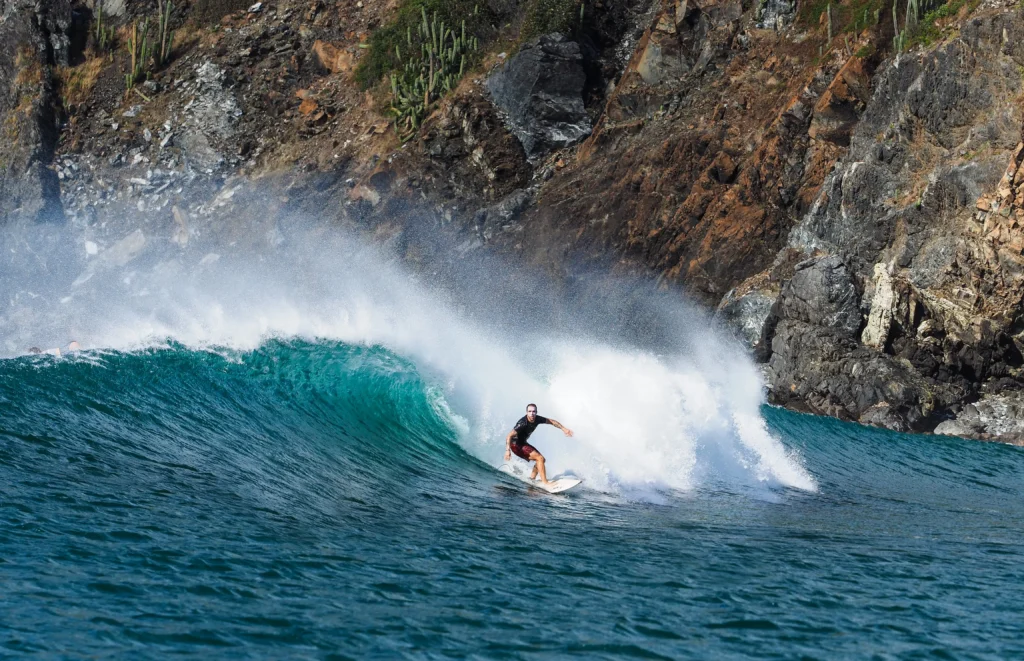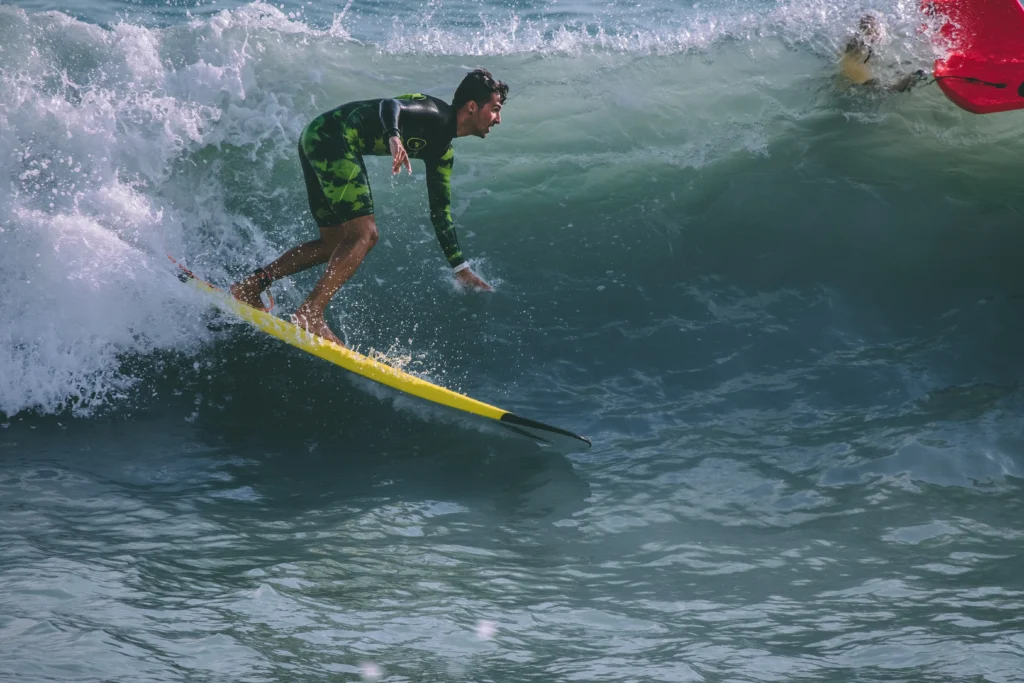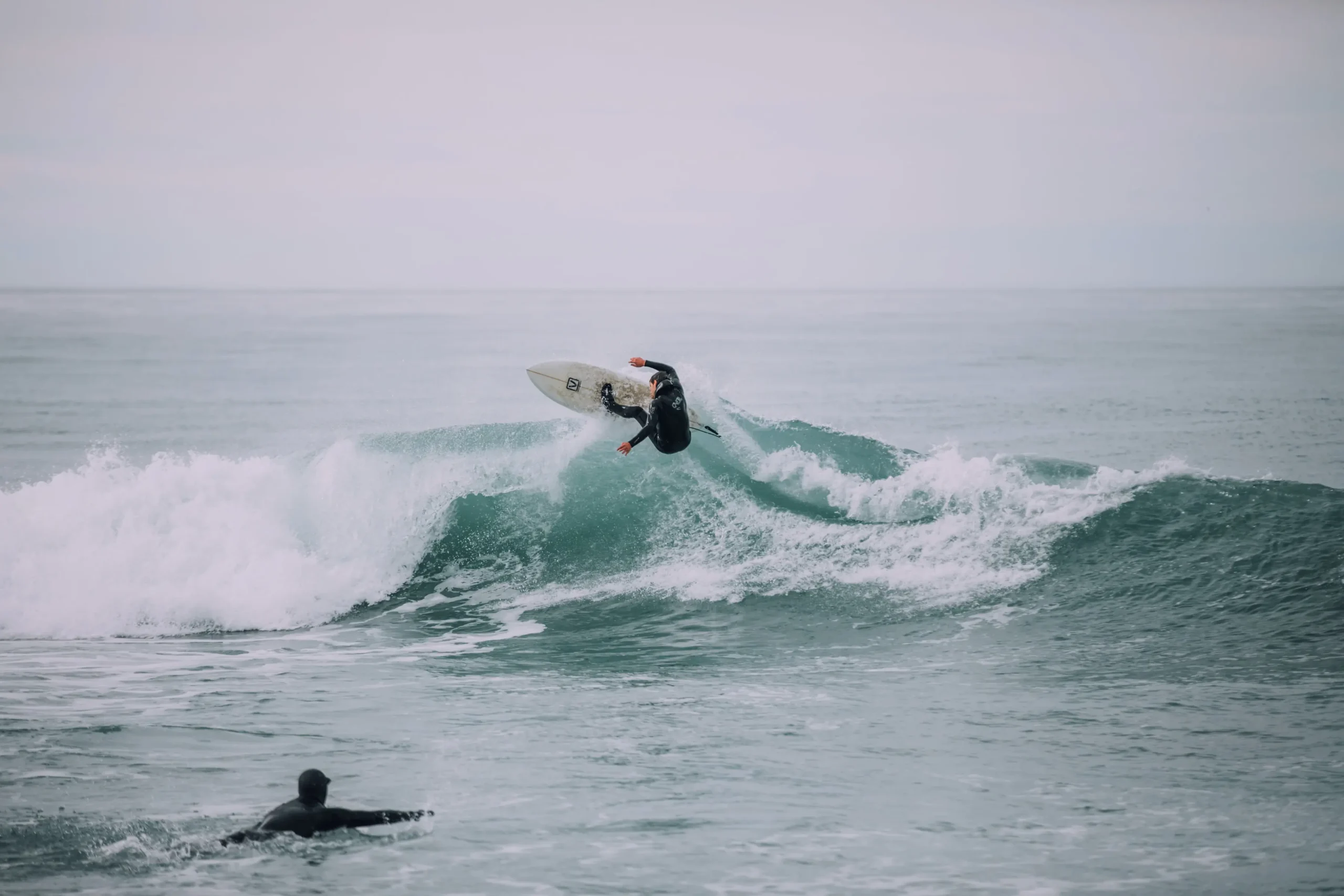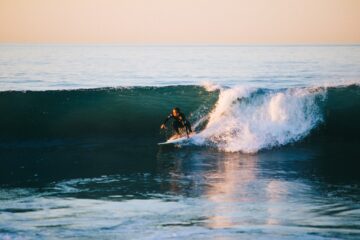What exactly makes a point break and why are these spots so prized by surfers? A point break refers to a surfing wave that hits a point of land or rock protrusion, causing it to refract and bend.
This focuses on the breaking wave, creating a powerful, hollow pocket. The concentrated rush of water makes point-break waves highly sought after.
Learn more about the bathymetry and ocean floor contours that create point break wave dynamics. Read On!
What Does Breaking Mean In Surfing?
In surfing, “breaking” refers to the moment when a wave loses its energy, causing the top to collapse and create a white, foamy surface. This happens as the wave moves from deeper to shallower water, making it ideal for surfers to ride along the wave’s face.
Characteristics of Point Breaks
Point breaks, unlike beach breaks, form along headlands or curved bays. They channel wave energy, creating longer, more focused breaks. This results in longer, smoother rides and predictable wave patterns, ideal for technical surfing.
Beach Break Blues vs. Point Break Bliss::
Beach breaks offer shorter, inconsistent rides. Reef breaks, with submerged hazards, can be unpredictable. Point breaks, however, are the stars of surfing. They provide
- Long, smooth rides, like a watery rollercoaster.
- Predictability, allowing for better surfing.
- A blend of challenge and reward, offering a sense of achievement.
Uniquely Point Break:
These breaks are set in beautiful, rugged locations, enhancing the experience. They foster a strong community among surfers. More than just waves, point breaks are destinations, offering a connection to nature’s power and beauty.
Why Surfers Love PointBreaks?
Long, Consistent Waves for an Exhilarating Experience
- Point breaks are a surfer’s dream. They offer long, rolling waves that provide an exhilarating ride.
- These waves are consistent, making them ideal for perfecting surfing techniques.
- The predictability of these waves allows surfers to enjoy a smooth, uninterrupted experience.
Suitability for Various Skill Levels
- Point breaks cater to everyone, from beginners to pros.
- New surfers find these waves less intimidating, as they break more gently than reef or beach breaks.
- Advanced surfers enjoy the challenge of maneuvering along the extended wave face.
Examples of Famous Point Breaks Worldwide
- Jeffrey’s Bay, South Africa: Known for its long, fast barrels, a favorite among pro surfers.
- Rincon, California: Offers mellow waves, perfect for longboarding and beginners.
- Noosa, Queensland, Australia: Famous for its scenic beauty and gentle waves, ideal for all levels.
From the iconic Jeffrey’s Bay to the serene Rincon, point breaks continue to captivate the hearts of surf enthusiasts.

Challenges and Considerations
Conquering these beauties demands more than just a board and bravado. Here’s a quick guide to navigating them with skill and safety:
Mastering the Dance:
- Timing is everything: Learn the “sweet spot” where the wave bends around the point. Paddle early for smaller swells, and hang back for powerhouses.
- Footwork finesse: Employ sharp bottom turns and tight carves to stay in the wave’s pocket. Think precision, not brute force.
- The line dance: Respect the “pecking order” – experienced surfers closer to the peak, followed by others. Etiquette goes a long way.
Respecting the Raw Power:
- Rocky sentinels: Be wary of hidden rocks, especially at low tide. Learn the break’s contours to avoid nasty surprises.
- Headland hazards: Powerful currents and rips can lurk near headlands. Always assess conditions and swim parallel to shore if caught.
Nature’s Wild Card:
- Wind and tide: They dictate wave shape and power. Choose wisely, or risk a bumpy, frustrating ride.
- Swell size: Know your limits. Overestimating your skills can turn exhilarating into terrifying.
N:B: Point breaks are fickle beasts. Approach them with humility, and respect for nature and fellow surfers, and you’ll be rewarded with rides etched in your surfing soul.
Point Breaks vs. Other Surf Breaks
Point Breaks Compared to Beach and Reef Breaks:
- Formation: Point breaks occur near headlands where waves wrap around the point. Beach breaks happen on sandy shores, and reef breaks over rocky or coral seabeds.
- Wave Consistency: Point breaks offer long, consistent waves. Beach breaks have shifting peaks due to sand movement, while reef breaks are known for steep, powerful waves.
- Safety: Point breaks are generally safer than reef breaks, which can have sharp coral. Beach breaks are safer due to their sandy bottom.
Influence on Surfing Style and Maneuvers
- Long Rides: Point breaks allow for extended rides, perfect for honing longboarding skills and smooth turns.
- Predictability: The consistent nature of point break waves aids in planning maneuvers and improving technique.
- Versatility: Surfers at point breaks can practice a variety of styles, from aggressive shortboarding to relaxed longboarding.

Finding and Surfing Point Breaks
Let’s unlock the secrets to finding and surfing these treasures:
Unveiling the Hidden Gems:
- Map Mania: Satellite images can reveal jutting headlands, potential sandbars, and hidden coves – prime suspect locations for point breaks.
- Local Lore: Befriend seasoned surfers. Their knowledge of secret spots and swell patterns is gold.
- Surf Communities: Online forums and groups buzz with intel on wave conditions and lesser-known breaks.
Taming the Point:
- Respect the Pecking Order: Experienced surfers claim the “peak” where the wave first breaks. Beginners hang back, observing etiquette and safety.
- Footwork Focus: Sharp turns and carves keep you in the wave’s pocket. Think smooth dance moves, not muscle mayhem.
- Timing is Key: Paddle early for smaller swells, hang back for monsters. Learn the “sweet spot” where the wave bends around the point.
Beginner and Beyond:
- Start Small: Gentle point breaks with forgiving sand bottoms are your training ground. Practice makes perfect!
- Find a Mentor: An experienced surfer can guide you through etiquette, technique, and navigating the break safely.
- Stay Humble: Mother Nature reigns supreme. Respect the power of the ocean and your own limits.
FAQs
How Do You Know if a Wave is Breaking?
A wave is breaking when its top starts to fall forward, creating a white, foamy crest as it moves towards shallower water.
What Creates a Point Break?
A point break is created when waves hit a land point, like a headland, causing them to bend and break along the coastline.
What Wave Can’t You Surf On?
Surfing is impossible on closeout waves, where the entire wave breaks at once, leaving no open face to ride along.
Which Type of Breakers Are the Best Waves for Surfing?
Point and reef breaks often provide the best waves for surfing, offering consistent, well-formed waves that allow for longer, more enjoyable rides.
Closing Words
Point breaks, with their unique formation and consistent waves, offer surfers of all levels a thrilling and rewarding experience.
They blend the excitement of long, smooth rides with the beauty of natural landscapes, making them a top choice for surfers seeking both challenge and enjoyment in the waves.




